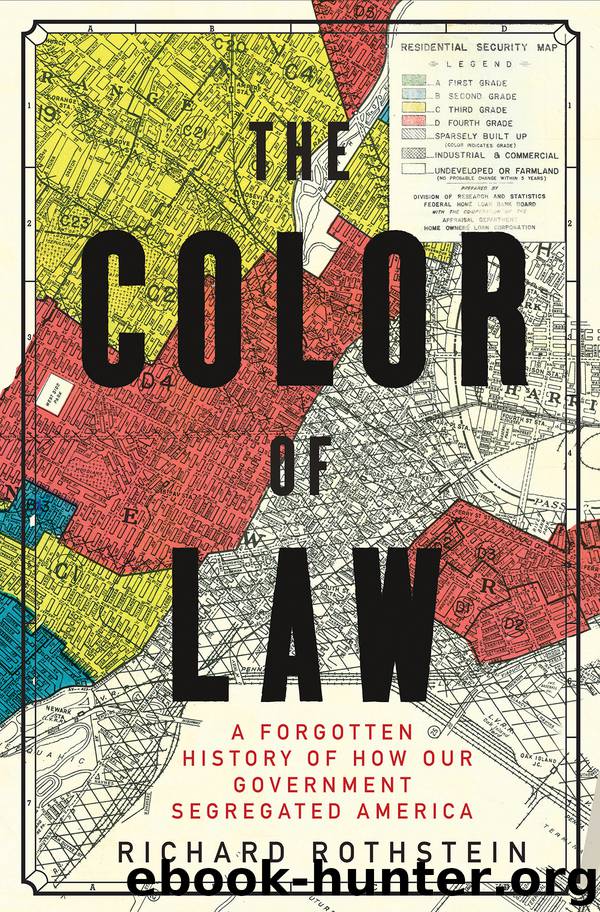The Color of Law by Richard Rothstein

Author:Richard Rothstein
Language: eng
Format: epub
Publisher: Liveright
Published: 2017-05-08T04:00:00+00:00
III
MEDIAN WHITE family income is now about $60,000, while median black family income is about $37,000—about 60 percent as much. You might expect that the ratio of black to white household wealth would be similar. But median white household wealth (assets minus liabilities) is about $134,000, while median black household wealth is about $11,000—less than 10 percent as much. Not all of this enormous difference is attributable to the government’s racial housing policy, but a good portion of it certainly is.
Equity that families have in their homes is the main source of wealth for middle-class Americans. African American families today, whose parents and grandparents were denied participation in the equity-accumulating boom of the 1950s and 1960s, have great difficulty catching up now. As with income, there is little mobility by wealth in America. In fact, intergenerational wealth mobility is even less than intergenerational income mobility.
An equal opportunity society with respect to wealth would operate similarly to an equal opportunity society with respect to income. No matter how wealthy your parents, you would have an equal chance, as an adult, of ending up anywhere in the national wealth distribution. But nearly half (41 percent) of children born to parents in the least wealthy fifth of American families remain in that lowest quintile as adults. Another 25 percent make it to the next-lowest wealth quintile, meaning that only one-third of children born to the least wealthy American families make it as high as the middle quintile in wealth.
As is true with income, African Americans are also less mobile in wealth than whites. Fewer than one-fourth of African American adults whose parents were in the bottom wealth quintile make it to the middle wealth quintile. Nearly twice as many (42 percent) white adults whose parents were in the lowest wealth quintile make it that far. Since African Americans were mostly prevented by government racial policy from owning single-family homes in the suburbs, it is not surprising that this would be so.
This difference becomes especially significant in that white families are more often able to borrow from their home equity, if necessary, to weather medical emergencies, send their children to college, retire without becoming dependent on those children, aid family members experiencing hard times, or endure brief periods of joblessness without fear of losing a home or going hungry. If none of these emergencies consume their savings or home equity, families can bequeath wealth to the next generation.
In 1989, the most recent year for which such data are available, 6 percent of black households inherited wealth from the previous generation. Of those who inherited wealth, the average inheritance was $42,000. Four times as many white households—24 percent—inherited wealth, and the average inheritance was $145,000. In that year 18 percent of black households received cash gifts from parents who were still living, in an average amount of $800. About the same share of white households received such gifts, but the average amount—$2,800—was much greater. This, too, is the consequence of government’s twentieth-century racial policy in housing and income.
Download
This site does not store any files on its server. We only index and link to content provided by other sites. Please contact the content providers to delete copyright contents if any and email us, we'll remove relevant links or contents immediately.
| Africa | Americas |
| Arctic & Antarctica | Asia |
| Australia & Oceania | Europe |
| Middle East | Russia |
| United States | World |
| Ancient Civilizations | Military |
| Historical Study & Educational Resources |
Cat's cradle by Kurt Vonnegut(13868)
Pimp by Iceberg Slim(12931)
Underground: A Human History of the Worlds Beneath Our Feet by Will Hunt(11257)
4 3 2 1: A Novel by Paul Auster(11050)
The Radium Girls by Kate Moore(10907)
American History Stories, Volume III (Yesterday's Classics) by Pratt Mara L(4826)
Perfect Rhythm by Jae(4621)
Wiseguy by Nicholas Pileggi(4586)
The Fire Next Time by James Baldwin(4343)
Paper Towns by Green John(4169)
A Higher Loyalty: Truth, Lies, and Leadership by James Comey(4033)
Pale Blue Dot by Carl Sagan(4001)
The Mayflower and the Pilgrims' New World by Nathaniel Philbrick(3914)
The Doomsday Machine by Daniel Ellsberg(3731)
Too Much and Not the Mood by Durga Chew-Bose(3694)
Killers of the Flower Moon: The Osage Murders and the Birth of the FBI by David Grann(3609)
The Borden Murders by Sarah Miller(3590)
The Sympathizer by Viet Thanh Nguyen(3481)
Killing England by Bill O'Reilly(3455)
